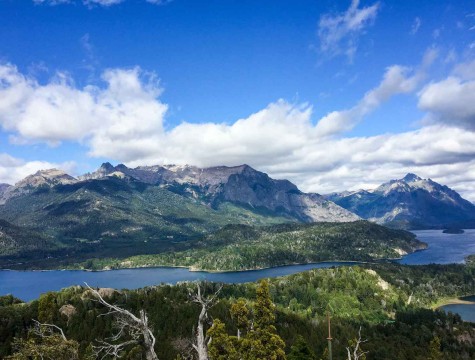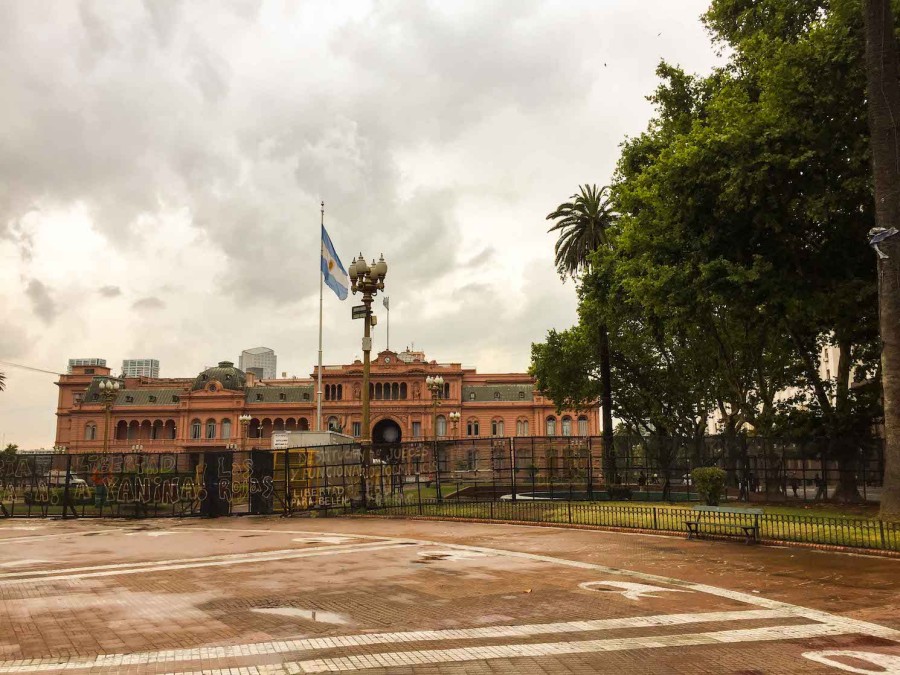Best trips while studying away at NYU Buenos Aires
If you’re considering Buenos Aires as a potential study away site and love to travel, be sure to check out these destinations.
Located in Buenos Aires, Argentina, la Casa Rosada is the office of the president of Argentina. (Staff Photo by Camila Ceballos)
May 2, 2022
BUENOS AIRES, Argentina — Fun fact: Argentina is the eighth-largest country in the world and the second-largest country in South America. There’s a lot of ground to cover if you’re studying away at NYU’s site in Buenos Aires. The semester goes by fast, so you want to make sure you take advantage of your time and visit as much as you can while in such a vast and naturally beautiful country.
Pro tip: Whenever you can, pay for your trips in cash. It will allow you to take advantage of the Blue Dollar rate — the black-market exchange for U.S. dollars outside of official entities like banks and, therefore, provides the best rate of exchange — and cut the cost almost in half. You can use a local travel agency to do so. I recommend Reflexos Viajeros, which is conveniently located less than two minutes away from the NYU Buenos Aires academic center. Booking.com is your friend in terms of finding hostels — you can reserve in advance for free and pay in cash when you get there.
Uruguay
This country is small but mighty. Just about two hours away from Buenos Aires on the Buquebus ferry across the Rio del Plata is Montevideo, Uruguay’s capital. The key word for Uruguay is vibes. I visited during our long weekend in February for Carnival, which Uruguay is famous for — they have the longest Carnival celebration in the world. Unfortunately, when I went, many events were canceled due to weather. Typically, however, you would find murgas — a form of musical performance — and people playing candombe music on the streets during this time of year.
An avenue that traces the city’s coastline, the Rambla of Montevideo also has built-in seating where you can relax and watch picturesque Uruguayan sunrises and sunsets. You can take a free city walking tour starting at Plaza Independencia, or tour the majestic Teatro Solis. While you’re there, make sure to try a chivito, an Uruguayan steak sandwich. I highly recommend taking the two-hour bus ride from Montevideo to the lovely beach town of Punta del Este for a day trip.
Hostel recommendations: Viajeros has a killer open-air patio and common social space, and Student’s Hostel is a lovely, quiet spot with friendly staff, clean bathrooms and great amenities.
Bariloche

Nahuel Huapi Lake immediately grabs your attention as you enter this Argentinian town in the mountain region of Patagonia. While the climb is a tad steep, the mountaintop Cerro Campanario is an absolute must-see and has one of the most breathtaking views I’ve ever seen in my life. You can also take a chairlift to the top, where there’s a lovely little cafe. I also recommend checking out some of the trails at Nahuel Huapi National Park. You can rent kayaks at Playa Bonita, a lake beach. Bariloche is considered the chocolate capital of Argentina — there’s a chocolate museum owned by major chocolate retailer Havanna, and major Argentine chocolate shops Mamuschka and Rapa Nui also have their original locations in Bariloche. You can also head up to the mountains and check out the quaint, picture-perfect chalet town Colonia Suiza (“Swiss Colony”) where you can find trinkets, eat and take zipline excursions. You can get around Bariloche using your SUBE card, the same public transport card used in Buenos Aires.
Hostel recommendations: Hostel Inn has a great staff and a deck with views of Nahuel Huapi Lake.
Ushuaia
Have you ever been to the end of the world? Ushuaia, known as “Fin del Mundo,” is at the very southern tip of South America and the closest you can get to Antarctica in the Americas. If you’re heading down to Ushuaia, make sure to bundle up. One of the highlights is taking the boat tour through Beagle Channel between Argentina and Chile. You’ll get to see sea lions, whales, cormorants — flying seabirds not to be mistaken with penguins — and, of course, penguins. You must check out Tierra Del Fuego National Park — make sure to flash your student visa for a major discount. There’s an adorable post office in the park run by a lovely elderly gentleman named Carlos. The Costera Trail is a standout, following the coastline of a major lake. If the conditions are rainy — which they often are — the trail can be kind of treacherous, so beware. The trail is definitely on the more advanced end of intermediate and takes about four hours to complete. I would advise you to start hiking as early in the day as possible and to bring snacks and a portable charger. Laguna Esmeralda is another natural beauty you can visit. Regarding restaurants, I recommend Bodegón Fueguino. Although I unfortunately didn’t get to try it, people line up for hours to try some of El Viejo Marino’s famous king crab.
Hostel recommendations: Los Cormoranes — a complete breakfast is included and the staff is super friendly, but Ushuaia is cold and you do have to walk outside for the communal bathroom, which isn’t ideal.
Iguazú Falls
Visiting Iguazú National Park can be done as a weekend trip, since the main attraction is the falls. The town of Puerto Iguazú, located on Argentina’s borders with Paraguay and Brazil, has a tropical rainforest climate. Indigenous Guaraní people, who are especially concentrated in Paraguay, have a prominent population in the city and sell goods in the national park. Iguazú Falls are stunning and majestic. After hopping onto the park train, you can start your day at Iguazú Falls’ largest waterfall, Devil’s Throat, before heading to the upper and lower circuits of the falls. You can also take a boat tour of the falls or cross onto the Brazilian side of the falls without a visa. A lovely spot to go to is Hito Tres Fronteras, where you can watch the sunset and see where the three countries of Brazil, Paraguay and Argentina meet, separated only by the Iguazú and Paraná Rivers.
Mendoza
This wine region is Argentina’s Napa Valley. In Mendoza, you can do a half-day wine tour that takes you to two vineyards and an olive oil factory and includes tastings for about $21. Plaza Independencia is the main plaza in the city and, during Easter, artists paint absolutely stunning scenes on massive eggs. The fair is also really nice — there are lots of booths where you can buy different artisanal crafts. You can also take your pick of a variety of affordable excursions in Mendoza, such as a horseback tour at sunset, a day-long bus tour of the Andes Mountains, a kayaking excursion, or a leisurely day in the thermal pools at Termas Cacheuta Spa. If you’re going during the highly popular Easter break, make sure to book your Mendoza excursions in advance. And finally — for the more adventurous — paragliding is an exhilarating excursion with insane views of the city and a great time for the cost of about $60. For nightlife, Avenue Arístides Villanueva is the liveliest street in town with tons of bars and eateries. I know we didn’t come to South America for the burgers, but Jack House was absolutely delicious — I had the Pinche Veggie burger and highly recommend it. There are also a lot of Peruvian food options, and if you’re feeling a little bougie, check out Vico Wine Bar Villa Crespo and try their delicious flan.
Honorable mentions: El Calafate is one of the most-visited tourist attractions in Argentina’s Patagonia region, where you can see the majestic and imposing Perito Moreno Glacier. If you’re a big hiker, El Chaltén, the hiking capital of Argentina, is not too far off.
Farther north are Salta and Jujuy, provinces known for their unique landscapes and breathtaking salt flats.
Contact Maureen Zeufack at [email protected].

























































































































































